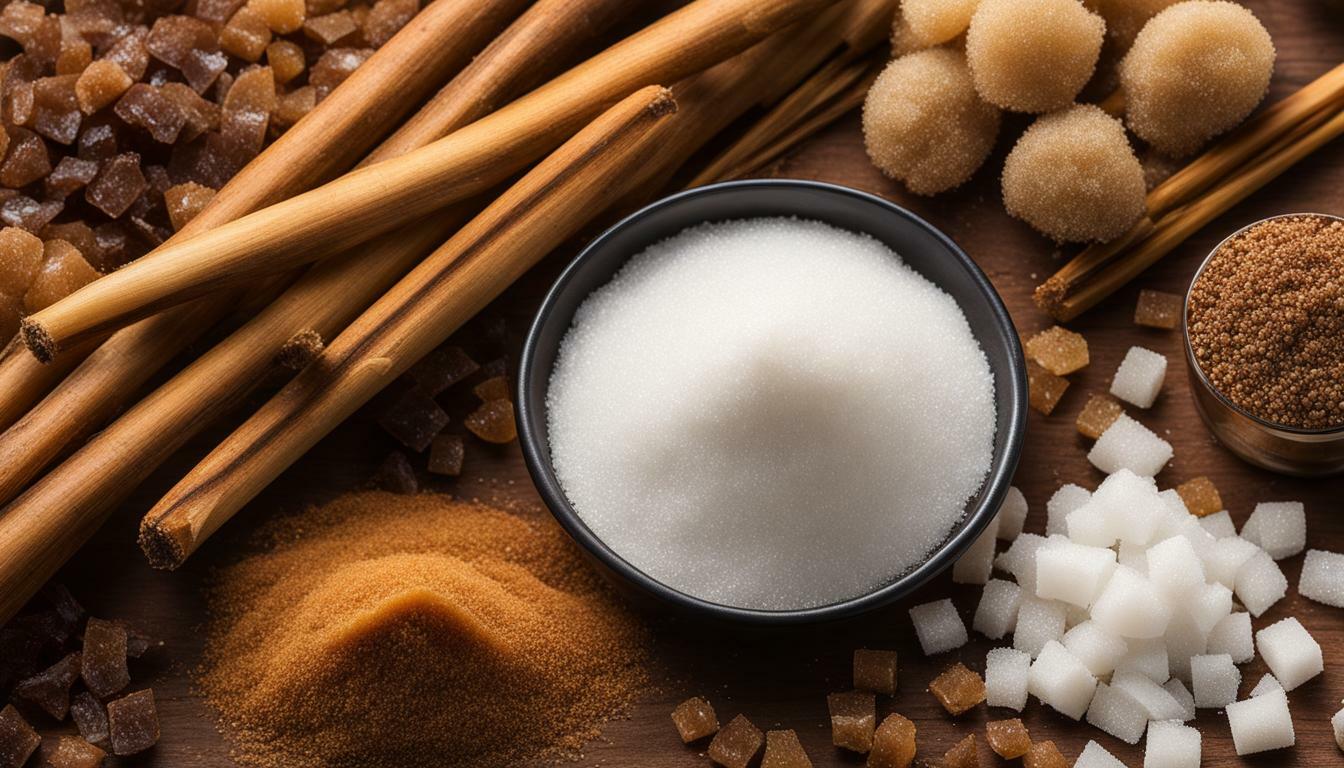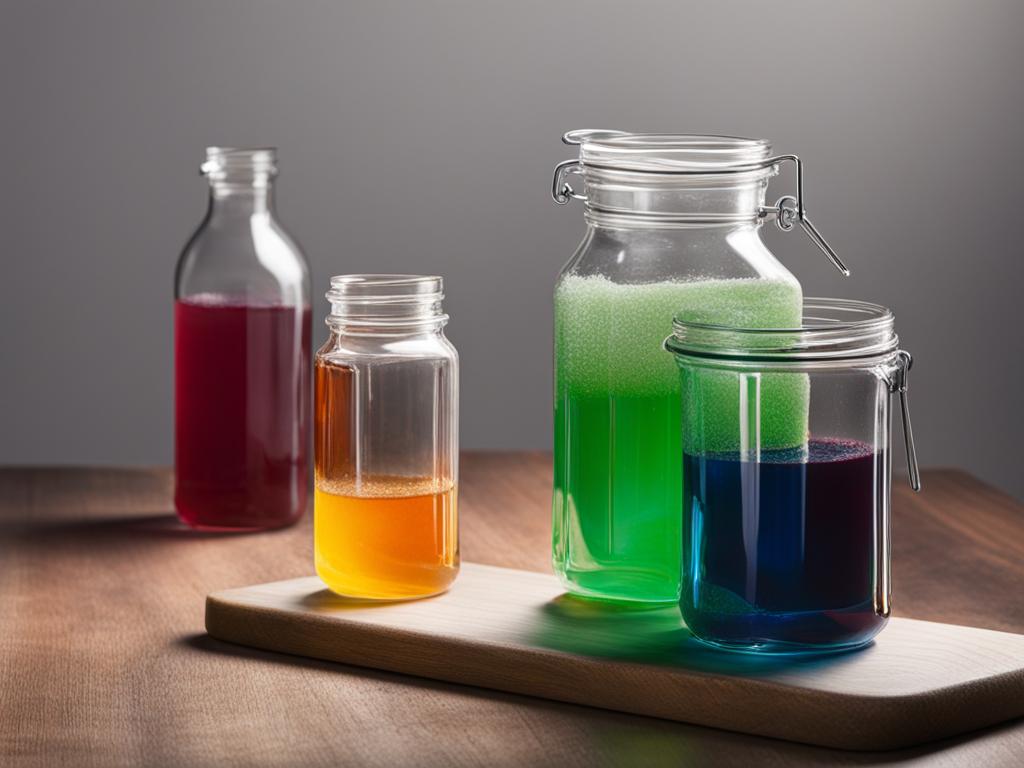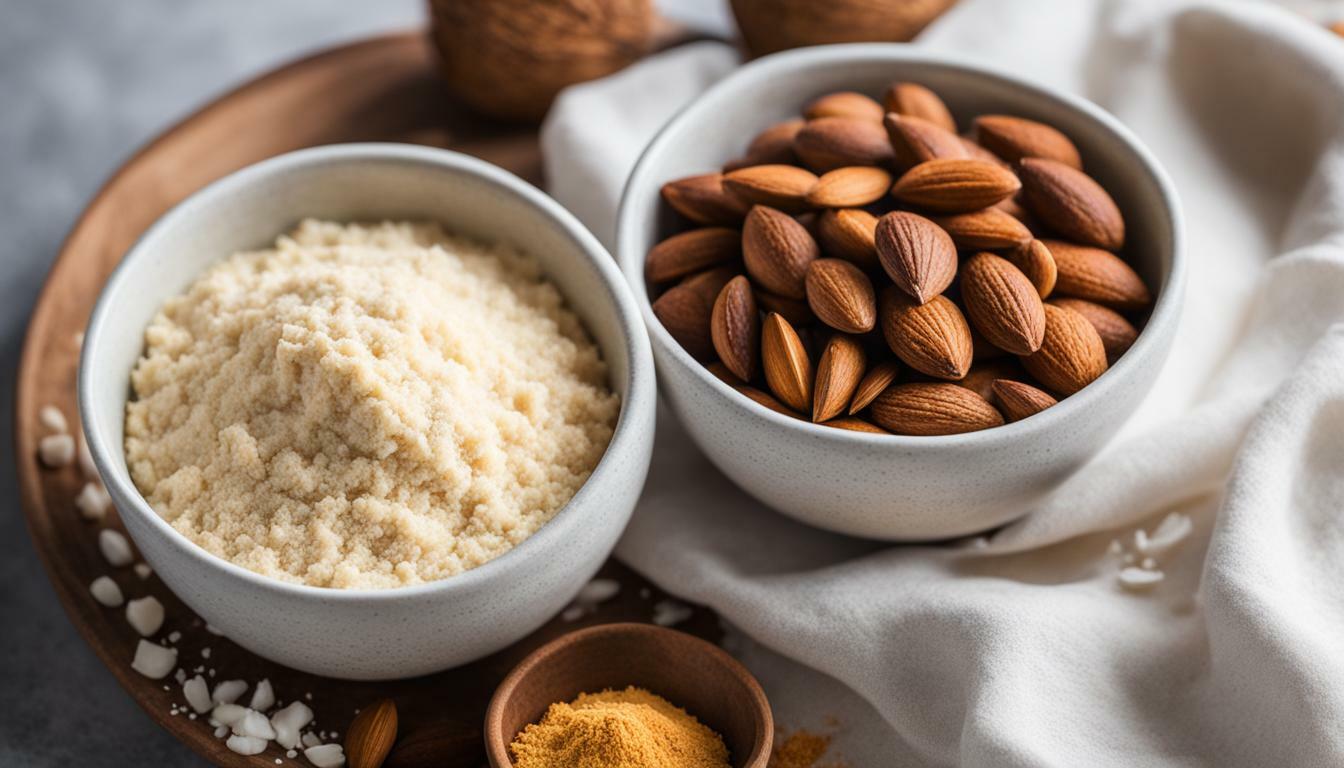Most of us enjoy a sweet treat every now and then, but have you ever wondered about the difference between white sugar and brown sugar? While they may look similar, there are key differences that go beyond just color. In this article, we will explore the various aspects of white sugar vs brown sugar, including their nutritional value, taste and appearance differences, and impact on health.
Key Takeaways:
- White sugar and brown sugar are two popular sweeteners that differ in color and taste.
- White sugar is produced by refining sugar cane or sugar beets and contains no molasses, while brown sugar is a mixture of white sugar and molasses.
- Brown sugar has a higher moisture content and a stronger, more complex flavor profile than white sugar.
- Both white sugar and brown sugar should be consumed in moderation as excessive sugar intake has been linked to various health issues.
What is White Sugar?
White sugar is the most commonly used sweetener in households worldwide. It is derived from sugar cane or sugar beets and undergoes a refining process to remove impurities and color. This refining process gives white sugar its characteristic appearance and texture.
In terms of nutritional value, white sugar is essentially pure sucrose, providing only empty calories and no essential nutrients. It can contribute to weight gain, tooth decay, and a host of other health problems when consumed in excess.
| White Sugar | Brown Sugar |
|---|---|
| Derived from sugar cane or sugar beets | Derived from sugar cane with molasses added back in |
| Undergoes a refining process to remove impurities and color | No refining process |
| Essentially pure sucrose, providing only empty calories and no essential nutrients | Contains trace amounts of minerals like iron, calcium, and potassium |
Compared to brown sugar, white sugar has a milder flavor and a higher sweetness level. It is commonly used in recipes where the goal is to achieved a light color and a delicate flavor profile, such as in meringues, angel food cakes, and sugar cookies.
However, the health effects of consuming white sugar in large amounts are no secret. It can lead to weight gain, high blood sugar levels, and other health complications when consumed in excess. That’s why it’s important to use it in moderation and opt for healthier sweeteners whenever possible.
What is Brown Sugar?
Brown sugar is a type of granulated sugar that is created by adding molasses to refined white sugar. The amount of molasses added determines the color and flavor of the resulting brown sugar. The molasses also gives brown sugar a slightly sticky texture, which is why it is sometimes referred to as “soft” or “moist” sugar.
Unlike white sugar, brown sugar undergoes minimal processing, which means it retains some of the natural minerals found in sugarcane. These include calcium, iron, and potassium, although the amounts are relatively insignificant and not nutritionally significant.
When it comes to nutrition, brown sugar is generally considered to be slightly more nutritious than white sugar due to its minimal processing and the presence of molasses. However, the differences are not significant enough to warrant incorporating brown sugar into your diet for health reasons alone.
Taste and Appearance Differences
One of the most obvious differences between white sugar and brown sugar is their taste and appearance. While white sugar is crystal white and has a neutral flavor, brown sugar comes in varying shades of brown and has a distinctive taste that is slightly caramel-like.
The reason for these differences lies in the production process of the two sugars. White sugar is heavily processed, with all impurities and molasses removed. Brown sugar, on the other hand, retains its molasses content, which gives it its color and flavor.
Due to its molasses content, brown sugar has a more complex flavor profile than white sugar. It adds depth and richness to baked goods, making them taste more complex and flavorful. It also tends to be slightly less sweet than white sugar, which can be beneficial in certain recipes.
In terms of appearance, brown sugar can be light or dark brown, depending on the amount of molasses it contains. Light brown sugar has a milder flavor than dark brown sugar, which has a more pronounced molasses flavor. When sugar is used as a topping or in certain recipes where its color could make a difference, brown sugar is a better choice than white sugar.
Choosing between Brown Sugar and White Sugar
Ultimately, the choice between brown sugar and white sugar comes down to personal preference and the recipe being used. When baking goods that require a neutral sweetener, such as angel food cake or meringues, white sugar is the best choice. However, for recipes where the complexity of flavor and the added moisture of brown sugar are important, such as in chocolate chip cookies or gingerbread, brown sugar is the way to go.
Remember, it’s important to understand the taste and appearance differences between white sugar and brown sugar so that you can choose the right sugar for your recipe. Brown sugar vs white sugar is a debate that has been going on for years, but the truth is that both types of sugar have their own unique qualities and can be used in a variety of recipes.
Uses in Cooking and Baking
White sugar and brown sugar have distinct uses in cooking and baking due to their unique properties. While both can add sweetness to your recipes, they serve different roles in achieving desired outcomes.
White sugar is commonly used in recipes where a lighter color and more delicate texture are desired, such as in cakes, meringues, and custards. It dissolves easily and helps create a finer crumb and softer texture in baked goods. Additionally, it is often used in recipes where a neutral flavor profile is desired, allowing other ingredients to shine.
Brown sugar, on the other hand, is used in recipes where a deeper flavor is desired, such as in cookies, gingerbread, and barbecue sauce. The presence of molasses in brown sugar adds a rich, caramel-like flavor and a chewy texture to baked goods. Additionally, it is often used in recipes that call for a darker color, such as in pie crusts and breads.
When substituting one sugar for the other in a recipe, it is important to keep in mind these differences in flavor and texture. In some cases, brown sugar can be substituted for white sugar to add more flavor, but this may also affect the texture of the final product. Similarly, substituting white sugar for brown sugar may result in a lighter color and less complex flavor profile.
Impact on Health
Both white sugar and brown sugar are high in calories and carbohydrates. One teaspoon of white sugar contains 16 calories and 4 grams of carbohydrates, while one teaspoon of brown sugar contains 17 calories and 4.5 grams of carbohydrates. However, brown sugar also contains slightly more minerals like calcium, potassium, and iron due to its molasses content.
Excessive consumption of either type of sugar can lead to weight gain, tooth decay, and an increased risk of chronic diseases like type 2 diabetes and heart disease. It is important to limit your overall sugar intake and opt for natural sources of sweetness like fruits and honey whenever possible.
Additionally, it is important to note that while brown sugar has a slightly lower glycemic index than white sugar, it is not a healthier alternative for individuals with diabetes. Both types of sugar can cause blood sugar levels to spike, and individuals with diabetes should closely monitor their sugar intake and consult with a healthcare professional for personalized advice.
Conclusion
Understanding the nutritional differences between white sugar and brown sugar is important for maintaining a healthy diet. While both types of sugar should be consumed in moderation, opting for brown sugar in some recipes can provide slightly more nutrients. However, it is crucial to prioritize natural sources of sweetness and limit overall sugar intake to protect your long-term health.
Conclusion
Understanding the difference between white sugar and brown sugar is essential for both culinary and health reasons. While they might look similar, they differ in taste, appearance, nutritional content, and health implications.
White sugar is the most commonly used sweetener, and it is produced by refining sugarcane or sugar beets. It is a simple carbohydrate that provides empty calories, contributing to weight gain, tooth decay, and chronic diseases.
Brown sugar, on the other hand, is a mixture of white sugar and molasses, which gives it a distinct flavor and color. It has slightly more minerals and antioxidants than white sugar, but it still contains calories and carbohydrates.
When it comes to cooking and baking, both sugars have unique properties that make them suitable for specific recipes. White sugar is ideal for making meringues, cakes, and cookies that require a light texture and a high rise, while brown sugar is best for producing moist and chewy baked goods such as brownies and gingerbread.
Overall, the key to a healthy diet is moderation and balance. Too much sugar, regardless of its color or type, can lead to adverse health effects. By being mindful of the amount of sugar we consume and its sources, we can make informed choices that support our well-being and enjoyment of delicious food.
 Skip to main content
Skip to main content


